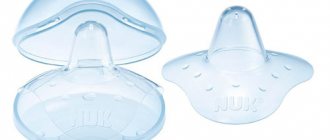The importance of breastfeeding
It is not always possible to master the practice of proper breastfeeding from the very beginning. Sometimes it takes a mother a while to understand how to hold her baby. The most important aspect is the correct latching of the nipple by the baby. If you cannot master this difficult task on your own, you can contact a specialist. The doctor will tell you how to hold the baby correctly. This will help him get the necessary amount of milk for harmonious development and growth.
In addition, the doctor will be able to identify such a common problem as a shortened frenulum of the tongue. This feature in a newborn is an obstacle to normal breastfeeding. This problem can be solved quite simply. The doctor trims the frenulum using special scissors. As a rule, no complications arise.
If you can’t see a specialist, and your baby is not latching onto the breast correctly, you can read the tips given below in the article. For your convenience, we have divided all the recommendations into points that should be followed one after another.
Frequent feedings
Feeding a baby on demand means that the baby is free to choose the frequency, duration of feeding and the amount of milk eaten. Each child develops individually, so all of the above factors may be different. Some babies eat very quickly, trying to get as much milk as possible at one time, usually they choke and then spit up. Other babies, on the contrary, suckle for a long time, often think and look up from eating. It all depends on the child’s temperament and character, even at such an early age.
Learning how to properly attach a newborn to the breast
So, as you can already understand, putting a baby to the breast is not such a simple matter.
You might be interested in: Menu for nursing mothers in the first month of lactation
Let's figure out how to do this correctly so that the newborn gets enough milk, and the mother does not have problems with cracks and pain.
Baby's position during feeding
Whatever feeding position you choose, the baby must be in the correct position. Its head and back should be level. If the baby is in a curled position, this is not correct. When positioned correctly, the newborn's chin should point upward. It should not be allowed to press against the chest. It is also important that mommy is comfortable. To do this, you can place a special feeding pillow under your back. It can be purchased online or in specialized stores.
You may be interested in learning about the best position to feed your newborn. Only useful information for you.
Guiding the child correctly
After you bring the baby to your breast and he opens his mouth, press him to you, while pointing your nipple towards his palate. Please note that when performing this manipulation, the baby's chin should touch the areola first. The baby should capture not only the nipple, but also almost the entire areola. If the size of the halos is small, the newborn may capture it completely. Don't worry, this is right. Later, the baby will understand how to properly latch onto the breast so that milk flows easily into his mouth.
Holding the baby straight
Each woman has her own breast size and shape. Try to find a position that allows your newborn to latch onto the nipple correctly, but you can also hold it as close to you as possible. Let us remind you that the baby’s chin should touch the chest, and its back and head should be positioned straight, without twisting. Also make sure that the mammary gland does not block the breathing of your son or daughter. The spout should be open and pointing upward.
You might be interested in: Newborn feeding positions
If the baby is not attached correctly, the baby may have breathing problems. It is important to ensure that it does not rest its nose on your chest.
Listen to your newborn
Monitor your baby while feeding. Remember, the nipple should point towards the sky, the chin should rest on the chest, the nose should be open, and the back and head should be level. At first, the little one will instinctively perform short movements that help stimulate the flow of milk. As soon as the milk comes, the baby's movements will become longer and slower. This indicates that everything is going as it should.
Pay attention to how the baby's jaw moves and whether there are sounds of swallowing and sucking. Their presence indicates that the baby is receiving milk. In addition, it is important to pay attention to the amount of urination the newborn has and weight gain. Using these indicators, you can determine whether the toddler is receiving enough milk.
What to do if the grip is incorrect?
If the mother feels that the newborn has taken the breast incorrectly, pain and discomfort have appeared, she should remove the baby and try to attach it to the nipple again, but this time correctly. You may have to make none of these attempts. Don't despair. Sooner or later the little one will understand what is required of him.
The right start is the key to good baby growth
Ideally, a newborn should be placed on the mother’s breast within 20–40 minutes after birth; this rule also applies to those babies born by caesarean section. The baby must master the new process of eating for at least two hours.
What you need to know about proper latching while breastfeeding:
- In any position, the baby's head and torso should always be on the same line.
- You can only lightly press the baby's tummy towards you.
- The nipple should be slightly higher than the newborn's head so that it is convenient for him to open his mouth as wide as possible.
- When supporting the breast from below, your fingers should be 5 cm from the nipple so as not to limit the suction area of the areola for the baby.
- The nipple and areola should be directed towards the top of the baby's mouth.
When choosing a maternity hospital, check the question of how quickly the baby will be put to the breast.
Why is it important?
The child gains experience in handling the breast, the woman’s body receives signals that everything is fine with the baby, and the recovery process after childbirth begins.
With the first drops of colostrum, the newborn receives the maximum amount of elements that contribute to the formation of strong immunity, vitamin A.
Colostrum is an excellent laxative and will help cleanse your baby’s body of excess bilirubin, which several times reduces the likelihood of developing jaundice in infants.
Indicators of correct latch on the breast in a newborn
If the baby has taken the breast correctly once, this does not mean that there is no need to further control this process. Every time you feed, it is important to look for signs of a good latch. Let's call them:
- The baby's nose is open and breathes freely.
- The chin is pressed to the chest.
- The newborn grasps not only the nipple, but also most of the areola.
- Mommy does not experience pain.
- The sucking process begins with short movements, and then the child makes longer and slower movements with his mouth.
- Sounds characteristic of swallowing are heard.
Each woman has a unique nipple shape. If they are flat and retracted, some difficulties may arise.
You might be interested in: How to wean your baby
Sometimes the doctor may recommend special silicone pads that make the sucking process easier for the baby.
Expert opinion
Ksenia Dunaeva
User experience expert and comment moderator. Higher medical education and more than 5 years of actual practice.
Ask Ksenia
Pain during breastfeeding, cracked nipples, poor weight gain, and insufficient urination are all signs of an improper latch. If you cannot master the correct breastfeeding tactics on your own, it is important to contact a specialist who will help you organize this process.
What is the volume of one serving of milk?
Every mother worries: does the baby have enough milk, is he well-fed. The volume of the portion eaten depends on the age of the baby. You can calculate the amount a child eats at one time: you must first weigh a hungry child, and then a well-fed one. Then subtract the first from the second result, this will be the volume of what the baby ate. Pediatric doctors have their own average standards regarding the amount of food for a newborn:
- On the first day
- ten grams per feeding, about ten to twelve applications per day, so from 100 to 120 ml per day. - On the second day
- about twenty grams at a time, respectively, per day - from 200 to 400 ml. - On the third day
, one feeding is thirty grams, so the amount per day is from 300 to 320 ml.
When a baby is ten days old, he eats up to 100 ml of milk at a time and about 600 ml per day. A child needs this amount of food until he is about one and a half months old. The baby is growing rapidly, and the milk he eats makes up about a fifth of his total weight. When a child turns two months old, his single serving is from 120 to 150 ml, and the daily norm is eight hundred milliliters of milk or a sixth of the total weight.
Breast care during breastfeeding
During feeding, it is important not only to position the baby correctly, but also to carefully care for the mammary glands. Let's look at how to do this:
- You should not wash your breasts before each feeding. This will cause it to dry out and lead to the appearance of painful cracks that do not heal for a long time.
- When attaching your baby, it is important to ensure that he grasps not only the nipple, but also the entire areola. If the halos are too large, the newborn should be able to grasp at least part of them.
- If your nipples are inverted or flat, you can use special silicone covers. You can buy them at the pharmacy.
- Immediately after finishing feeding, try to keep your nipples open. This can be done while you are carrying the baby vertically to allow excess air to escape.
- After this, wipe your breasts with a napkin or wash with warm water without soap. Apply moisturizer or sea buckthorn oil.
If the baby has eaten enough and there is still milk left in the mammary glands, you should express it.
This will help stimulate milk production later on and also prevent mastitis. Expressing can be done manually or using a breast pump.
What is included in the mixture
The basis of formulas for feeding children is whey, which has undergone a process of hydrolysis (decomposition) and demineralization, so it is well absorbed in the child’s body. Such mixtures are called adapted or hypoallergenic. If the mixture is made on the basis of casein, then it is more suitable for children older than six months. It may simply not be absorbed into the baby’s body. They are also called partially adapted. If the mixture includes bifidobacteria, then this is very good. Examples of such nutrition: Similak, Nestozhen, Impress, Enfamil. If lactose intolerance is detected in a child, he can be fed formulas based on soy milk (Nutria-soy, Bona-soy).
WHO recommendations
Any mother wants her baby to feel good during breastfeeding, so many women are interested in how to properly feed a newborn with breast milk. Before breastfeeding, a young mother should study the WHO recommendations for breastfeeding, recorded in an official document. Basic rules of breastfeeding:
- In the first days of life, the baby eats little, so he gets enough colostrum, which is a useful product that contributes to the normal development of the child’s body. In this case, there is no need to additionally give the newborn warm water, which puts a strain on his fragile kidneys.
- If possible, you should not feed your baby artificial milk formula. This can lead to disruption of the intestinal microflora.
- During breastfeeding, a nursing mother should constantly be close to her baby, which will help the newborn quickly adapt to new conditions, as well as establish contact between mother and baby.
- The basis for successful breastfeeding is the correct attachment of the baby to the mother’s breast.
- Provide nutrition to the baby as required. There is no need to create a feeding schedule; the baby must want to eat himself. This will help strengthen his psychological health, improve the production of maternal product, and prevent the occurrence of lactostasis. At the same time, the baby will always be full and gradually gain weight.
- In addition, a nursing woman should provide special care for her breasts, washing them no more than 1 - 2 times a day, mainly with the help of a shower. You should not use soaps that wash away the natural fats that protect the nipple and skin. Also, during breastfeeding, you should not use deodorants or perfume. A smell that is too strong can repel a child.
- WHO recommends avoiding the use of pacifiers. Getting used to a pacifier, the baby asks for the breast less often and is lazy to suck milk, resulting in malnutrition and weight loss.
We recommend reading: How to increase breast milk lactation
The World Health Organization advises mothers to feed their babies until they are 2 years old. However, the age at which breastfeeding stops should be determined by the nursing woman, which depends on several factors.











